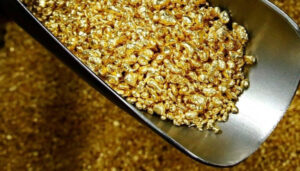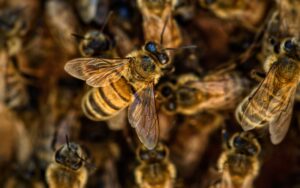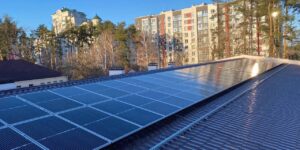
World central banks in November, according to preliminary estimates by the World Gold Council (WGC), increased the amount of gold in their foreign exchange reserves by 53.4 tons.
“Looking to the end of 2024, central banks around the world continued to play a leading role in gold demand,” said WGC analyst Krishan Gopaul. – “November was another month of gold purchases, with central banks adding a total of 53 tons to official reserves, according to available data. This continues the trend observed throughout the year: central banks, mostly from emerging markets, remained active buyers of gold, driven by a desire to find a stable and reliable asset in the face of global economic uncertainty.”
The largest buyers of gold in November were Poland (21 tons), Uzbekistan (9 tons), India (8.4 tons), and Kazakhstan (5.1 tons). According to Gopol, for the first time since April, China reported an increase in reserves (plus 5 tons). Other buyers included Jordan (4.1 tons), Turkey (3 tons), the Czech Republic (1.6 tons), Ghana (1.2 tons), Mongolia and Malta (less than a ton).
Singapore was the main seller of gold (5.2 tons). Also in December, the central bank of Finland reported a 10% reduction in its gold reserves to 44 tons, a sale that most likely took place the same month, WGC said.

Registrations of new commercial vehicles (trucks and special vehicles) in 2024 increased by 14% compared to 2023 – up to 12.9 thousand units, Ukrautoprom reported.
According to the association, the Renault brand confidently retained its leadership at the end of the year with 3,271 thousand vehicles registered, Citroen took second place with 1,205 thousand, and MAN took third place with 993 units.
The top ten most registered new trucks and special vehicles in 2024 also include Ford – 844 units; Scania – 761 units; Mercedes-Benz – 625 units; Peugeot – 614 units; Volkswagen – 554 units; Iveco – 545 units; and Hyundai – 474 units.
The Association informs that in December, this market segment grew by 17% by December 2023 and by 24% by November 2024 – up to 1.354 thousand units.
As reported, in 2023, according to Ukravtoprom, registrations of new commercial vehicles in Ukraine increased by 65% by 2022 to 11.3 thousand units.

According to preliminary data, the turnover of the ATB chain in 2024 increased by 15% compared to 2023 to UAH 248.3 billion, said Serhiy Demchenko, Head of Corporate Communications at ATB Corporation.
According to him, in 2024, the chain added 47 new stores, and another 11 retail facilities were reconstructed.
As of the beginning of 2025, the ATB chain has 1257 stores.
According to Mr. Demcheko, last year ATB also launched a new own brand, Day in Day.
In 2024, the company’s investments increased by 25% (by UAH 3 billion) compared to the previous year and amounted to almost UAH 15 billion. Particular attention was paid to energy security, he noted.
“We have equipped ATB stores with generators (DPS): more than 1.2 thousand stores are currently equipped, which is 98% of the entire network. We also equipped our stores with solar power plants (SPP). To date, 40 stores have been equipped with SPPs, and another 180 stores are in the process of being equipped,” he said in a post on Facebook.
ATB Corporation also installed gas turbine equipment at a distribution center in Khmelnytsky region.
The company has also invested UAH 185 million in a project to pool reusable packaging for fruits and vegetables. As noted, the reusable containers are made of safe types of plastic. Today, ATB uses more than 400 thousand boxes and 15 thousand pallets of such containers.
In addition, the chain sent more than 213 tons of used batteries for recycling to Romania and Poland.
Demchenko stated that in 2024, the corporation created more than 3.5 thousand new jobs, and the total number of employees reached 56 thousand. The amount of taxes and fees paid to the budgets of various levels and special funds preliminarily amounted to UAH 30.7 billion, which is 22% more than in 2023.
In addition, ATB Corporation provided charitable assistance to the Ukrainian Defense Forces in the amount of over UAH 2 billion.

In 2024, omnichannel retailer Foxtrot opened five new stores and reformed eight outlets, the chain’s press service reports.
According to the report, new stores were opened last year in Chernihiv, Ivano-Frankivsk, Zaporizhzhia, Kryvyi Rih and Stryi (Lviv region). The company also reformed eight stores in Kyiv, Odesa, Bila Tserkva and other cities. As of the end of the year, the chain had 124 stores in 66 cities.
The retailer has also equipped its stores to meet the requirements of inclusiveness and barrier-free access, including the integration of a service for customers with hearing impairments.
Last year, Foxtrot also launched a warehouse at a new location in Kyiv region, expanding its area to 28 thousand square meters.
By the end of 2024, the chain increased its turnover by 13% year-on-year and increased online sales on the Foxtrot.ua platform by 42%. In addition, the retailer has started cooperation with Kasta and market by mono marketplaces, the press service emphasizes.
It is noted that the number of participants in the chain’s loyalty program increased by 1.1 million to 15 million registered customers.
The retailer also continued to support the Ukrainian Defense Forces: by the end of 2024, the chain handed over electronics worth UAH 14.2 million to the military. Since the beginning of the full-scale invasion, Foxtrot has donated UAH 42.5 million worth of gadgets to the army.
“Foxtrot is one of Ukraine’s largest omnichannel retail chains in terms of the number of stores and sales of electronics and home appliances. The company operates 124 stores in 66 cities, including the frontline cities of Kherson, Kramatorsk and Sloviansk, an online platform Foxtrot.ua and a mobile application of the same name.
According to Opendatabot, the net revenue of FTD-Retail LLC (Kyiv), which develops the chain, increased by 29% to UAH 12.6 billion in 2023, with net profit of UAH 314.4 million compared to a loss in 2022.
The Foxtrot brand is developed by the Foxtrot group of companies. The co-founders are Valery Makovetsky and Gennady Vykhodtsev.

In Ukraine, in 2024, the mortality rate of bees in the controlled area was 20-25%, which is significantly higher than pre-war figures and is explained by unfavorable weather conditions in spring and summer, which led to a reduction in the area of honey plants, Volodymyr Postoenko, director of the Prokopovych Institute of Beekeeping, told Interfax-Ukraine.
“The year 2024 was very difficult for beekeepers due to a sharp climate change. In spring, white acacia is very important for the development of bee colonies. During its flowering period, there were frosts all over Ukraine. Bees did not get honey from it. Then there was a problem with an important honey plant – sunflower. Due to the drought, its yield was low, it did not produce nectar and there was no development of bee colonies. This led to high bee mortality, which in different regions amounted to 15-20%, and sometimes 23-27%. The national average was 20-25%,” the scientist said.
According to him, such a high mortality rate of bee colonies in Ukraine was not observed before the war. Earlier, bee mortality in Ukraine was mainly associated with the lack of information on chemical field treatment by farmers. Bee mortality from pesticides was also significant in different regions. However, the state has introduced a number of legislative initiatives that allow beekeepers to defend their rights in courts.
Postoenko noted that before the war, the mortality rate of bees from viruses and diseases in Ukraine was low, and only domestic bees were grown in the country. The situation has worsened as foreign bee breeds that do not have the necessary resistance to existing regional diseases have been introduced into production.
The scientist added that in a number of countries in different years, the mortality rate of bee colonies reached 80-90%, which is why society is concerned about the problem of bee mortality.
The director of the Institute of Beekeeping pointed out that the Ukrainian beekeeping industry, like a number of others, does not have reliable statistics, as only 5% of beekeepers are engaged in industrial production, and the remaining 95% are represented by households. They, in turn, are in no hurry to register their apiaries, which is why reporting on their activities is approximate.
“Before the war, according to unofficial statistics, there were 3-3.5 million bee colonies in Ukraine. (…) In addition, unofficial statistics say that the apiaries that were in the current occupied territory before the war accounted for about 30% of the total number of apiaries in Ukraine before the war,” the expert added.
In a comment to Interfax-Ukraine, Hanna Burka, project manager of the Food and Agriculture Organization of the United Nations (FAO), said that in 2023 the number of bee colonies in Ukraine amounted to 2402.9 thousand, which is 10.5% less than in 2022.
Burka emphasized that the rate of decline in bee colonies in industrial enterprises was higher – 13.6%, to 32.5 thousand, and in households – by 10.5%, to 2379.4 thousand,
According to her information, as of January 1, 2024, there were 2314 thousand bee colonies in Ukraine, of which 2286 thousand were in households, and 28 thousand families were in enterprises, of which 4 thousand families were in farms.
As of January 2024, the top five regions in terms of beekeeping were Khmelnytskyi region with 376.6 thousand bee colonies, Vinnytsia region with 188.9 thousand, Kirovohrad region with 149.9 thousand, Zhytomyr region with 149 thousand, and Ivano-Frankivsk region with 140.5 thousand bee colonies.
At the same time, the most developed industrial beekeeping in 2024 was in Poltava region, where 4.6 thousand bee colonies are located, Vinnytsia and Cherkasy regions have 3.3 thousand bee colonies each. In Khmelnytsky region, there are 1.9 thousand bee colonies in the industrial segment, and in Kyiv region – 1.7 thousand bee colonies. Households in Khmelnytskyi region are the leaders in keeping bee colonies – 374.7 thousand, Vinnytsia region – 185.6 thousand, and Kirovohrad region – 148.8 thousand.
The Ministry of Agrarian Policy and Food, responding to an information request from Interfax-Ukraine, confirmed the experts’ information and added that before the full-scale war in Ukraine, as of January 1, 2022, the number of bee colonies in the country was 2686 thousand. During the two years of the full-scale war in Ukraine (2022-2023 – IF-U), the number of bee colonies decreased by 13.8% and amounted to 2,314 thousand.
“As a result of the hostilities of the Russian Federation on the territory of Ukraine, the livestock sector, in particular the beekeeping industry, has suffered destructive and destructive configurations,” the Ministry of Agrarian Policy emphasized.
The Ministry referred to an assessment by experts from the Kyiv School of Economics (KSE), according to which, as of December 31, 2023, losses due to the reduction of bee colonies in Ukraine are estimated at $31.9 million, excluding losses from a decrease in beekeeping production.

Nova Poshta, the leader in express delivery in Ukraine, has launched a 1 MW solar power plant (SPP).
“A megawatt power plant has been launched on the roof of Nova Poshta’s Kyiv Innovation Terminal. The field of solar panels stretches over an area of 5 thousand square meters,” the company’s co-owner Volodymyr Popereshniuk wrote on Facebook on Monday.
The total investment in the project amounted to UAH 14 million.
The expected payback period is three years.
Popereshniuk announced plans to install industrial uninterruptible power supply systems and energy storage equipment to improve the efficiency of energy facilities.
“The key to the growth of investments in our energy independence, in particular, was the abolition of VAT on imports of energy equipment. We were able to launch our energy program, develop renewable energy sources and reduce consumption from the general power grid,” said the co-owner of Nova Poshta.
As reported, in April 2023, in response to Russian strikes on the power grid, Nova Poshta established Nova Energy to develop regular electricity generation and ensure the autonomy of the company’s facilities. Since August, the company has been selling small wholesale diesel fuel on the open market.
Mr. Popereshniuk announced plans to install industrial uninterruptible power supply systems and energy storage equipment to improve the efficiency of energy facilities.
“The key to the growth of investments in our energy independence, in particular, was the abolition of VAT on imports of energy equipment. We were able to launch our energy program, develop renewable energy sources and reduce consumption from the general power grid,” said the co-owner of Nova Poshta.
As reported, in April 2023, in response to Russian strikes on the power grid, Nova Poshta established Nova Energy to develop regular electricity generation and ensure the autonomy of the company’s facilities. Since August, the company has been selling small wholesale diesel fuel on the open market.
Popereshnyuk said that after the war ends and the situation with energy supply improves, Nova Energy will be sold as a non-core business.